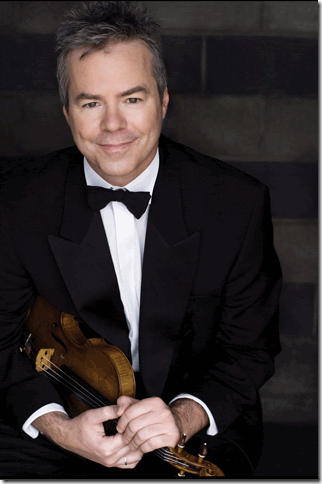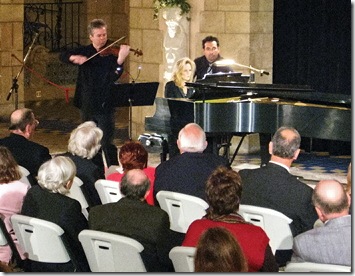The violinist Frank Almond was equal parts artist and advocate Tuesday night as he opened the Flagler Museum’s 2010 concert series, making an eloquent case for the music of Clara Schumann.
Almond, concertmaster of the Milwaukee Symphony Orchestra, performed one of the German pianist’s Romances for violin twice in a broad-ranging recital that showed off this performer’s quiet mastery of his instrument, and not incidentally the instrument he was playing, a 1715 Stradivarius that once belonged to the Polish violinist Karol Lipinski, a friend of Clara and her husband Robert.
The Romance (Op. 22, No. 1) turned out to be a lovely work, very much like that of Max Bruch in its melodic style and direct emotional appeal. Almond played it first in the second half of the program after remarks about history’s unjust neglect of Clara Schumann’s work, and then played it again for the encore, just as persuasively as he had done 30 minutes earlier.
Beautiful as the piece was, the other works on Almond’s list offered more fulfilling music, such as Robert Schumann’s late Violin Sonata No. 2 (in D minor, Op. 121). Here is a work that truly has been unfairly overlooked, a powerful piece every bit as sweeping, majestic and intense as the Brahms sonatas that get played more often.
From its titanic chords for violin and piano at the opening to the dark, rolling theme that opens the finale, this sonata is the work of a master composer and a first-rate musical dramatist. Almond, whose excellent accompanist for the evening was Robin Arrigo, played with passion and a kind of technical polish in which triple-stops seemed to be little strain and the range of all required effects from delicate pizzicato chords to long-breathed melodies were beautifully handled.
That same sense of thorough achievement was on display as well in the opening work, the Sonata in G minor (Devil’s Trill) of the Baroque composer Giuseppe Tartini, thought to be the first owner of the violin Almond was playing. Almond’s reading of the first two movements was noble and strong, and in the Author’s Dream section, the numerous trills with countermelodies moved coolly by, building slowly to the drama of the cadenza.
Almond’s tone approach here was for me a bit too rough; much of the music had an attacked quality to it that was somewhat harsh, though the intent was likely just to add vigor to a style of music that often gets wrongly played with kid gloves.
The violinist’s finest work came in the Violin Sonata (in G) of Maurice Ravel, which opened the second half. Almond is a superior performer of this music, a player who brought an intense, perfectly focused tone to the long, melancholy melodies of this great French work, and made them heartbreaking. The first movement was particularly notable for the purity and beauty of his conception, right down to the impossibly long ending note, which lasted on even after Arrigo had stopped.
The second movement (Blues) further showcased Almond’s range, as made full use of its sly portamenti without being over the top, and in the finale, he brought to the music the proper sense of a steadily running machine, an effect that helps account for its charm. Arrigo was a shade too loud at the beginning of the movement, covering up the start of the perpetual motion in the violin and detracting somewhat from the effect.
The formal concert ended with two pieces by Sarasate: Malagueña (Op. 21, No. 1) and the Introduction and Tarantella, Op. 43. With the Malagueña, Almond offered an entirely new tone color, a huge, highly Romantic sound, rich and full of the sensual appeal of Spanish folksong. And his technical command stood him in good stead for the Tarantella, where he was able to make a clear distinction between the galloping around that constitutes the main theme of the piece and a contrasting theme, which here had shape and wit.
Frank Almond is the kind of player that shows you that the orchestras of the United States are in good hands. His profile might not be as high as some of today’s more celebrated soloists, but he embodies the same thing they do: Fine technique, interpretive sophistication and an abiding commitment to the music — even to the point of making a pretty solid case for Clara Schumann.
Next up in the Flagler series is the Leipzig String Quartet, which plans music by Haydn (the Sunrise Quartet, Op. 76, No. 4), Mendelssohn (Quartet No. 6 in F minor, Op. 80) and Leos Janacek (Quartet No. 2, Intimate Letters). The concert is set for 7:30 p.m. Tuesday, Jan. 26, at the Flagler Museum on Palm Beach. Tickets: $60. Call 655-2833 or visit www.flaglermuseum.us.

